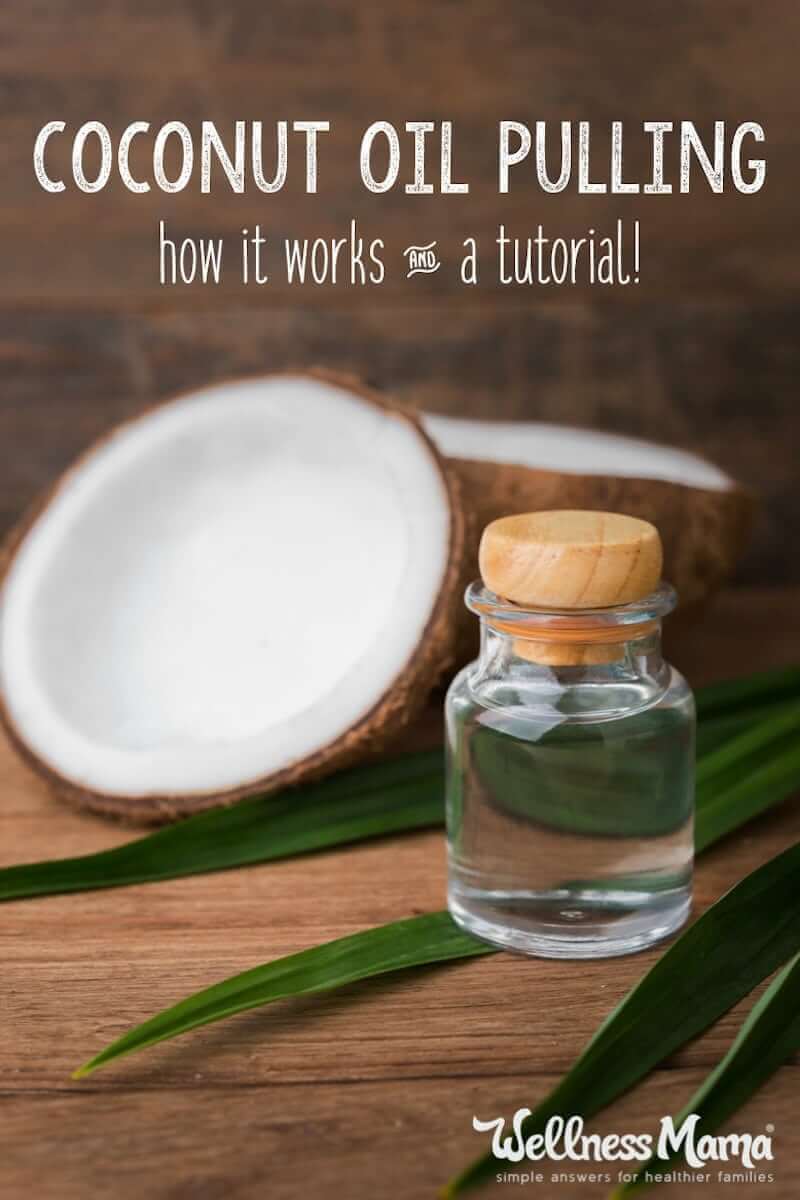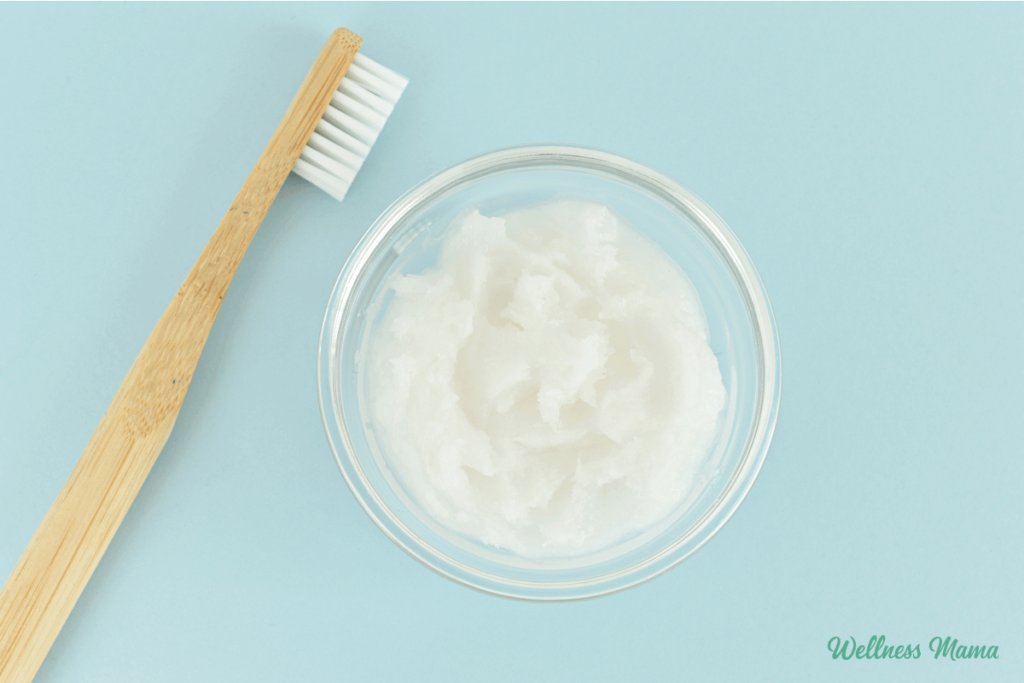Coconut oil pulling has gained mainstream attention in the news and on fashion blogs in recent years. I’ve been using this Ayurvedic oral health practice off and on for years, and I’ve seen noticeable effects. It was one of the tools I used to remineralize my teeth and reverse tooth decay.
Although it’s somewhat controversial, oil pulling has existed for thousands of years. The practice not only offers health benefits for our mouths, but in caring for our mouths, we’re caring for our bodies. Oral health goes beyond the health of our teeth and gums. (Listen to this amazing podcast with a dentist).
Adding coconut oil pulling to your dental hygiene routine is a great way to support a healthy mouth and body. It’s one tool that should be in your dental health toolkit!
What is Oil Pulling?
Oil pulling is an ancient remedy from the Ayurveda practice that originated in India thousands of years ago. It involves taking a small amount of high-quality, organic oil and swishing it in your mouth (like a mouthwash) for 15 to 20 minutes.
Various oils can be used for oil pulling, but they need to be food-grade (edible oil). And it should be something you’d eat (so high-quality). I prefer to use coconut oil because of its many health benefits and antibacterial properties.
It could be called “oil-swishing,” as the word “pulling” can be confusing. The term pulling refers to the idea that the oil pulls bacteria out of the gums.
Coconut Oil Pulling Benefits
There are lots of benefits of oil pulling. It’s a great complement to an oral care routine of brushing and flossing. And it’s much better than using conventional mouthwash, often full of toxic chemicals and alcohol. Using coconut as your oil of choice is a great way to benefit from this amazing oil.
When you swish with oil, it binds to the biofilm, or plaque buildup, on the teeth. This helps reduce tooth decay and strengthens gum health. This helps prevent cavities and gingivitis. It also removes harmful bacteria that can cause periodontitis, tooth decay, and halitosis (bad breath).
Some sources claim that oil pulling with coconut can help everything from acne to sore throats and even heart disease. But I’ve never seen any scientific documentation of these claims. However, it’s well known that good oral health practices can benefit overall health. This includes lowering the risk of diabetes and heart attacks.
I wouldn’t rely on it alone to address any internal or serious medical problem, but I find it helpful to keep my mouth healthy and avoid bad breath.
Does Oil Pulling Work?
Oil pulling has been shown to reduce the number of Streptococcus mutans bacteria in the mouth, especially when done with coconut oil. Streptococcus mutans is one prominent bacteria in the mouth. It’s been linked to tooth decay and gum disease.
There’s also scientific evidence that it’s as effective as chlorhexidine mouthwash in reducing bacteria. Chlorhexidine is a common antiseptic that’s used as a mouth rinse. It’s also a possible neurotoxin. I’d much rather use coconut oil than that!
Does Coconut Oil Pulling Whiten Teeth?
Although there isn’t scientific evidence showing that it’s good for teeth whitening, I found it worked for me. In my experience, using coconut oil for oil pulling helped whiten my teeth. My teeth felt smoother and looked whiter after adding in this practice. A 2017 study found oil pulling helps remove plaque which causes enamel to look yellow.
However, I won’t rely on this practice alone to whiten my teeth. I also use a few other practices, including brushing with whitening toothpaste and a toothpaste containing charcoal (that really helps to whiten!).
Coconut Oil Pulling Dangers
It’s important to use oil pulling as part of a comprehensive oral health regimen and not to replace normal oral hygiene. Oil pulling is a great addition to brushing twice daily, flossing, and regular dental checkups.
There aren’t any side effects of oil pulling. However, some people report negative reactions to coconut. Anyone with any topical or internal reaction to coconut in any form (especially an allergy to it) shouldn’t use it for oil pulling. In these cases, sesame oil would be a better alternative.
Some people have raised concerns about oil pulling with amalgam or mercury based fillings. Holistic dentist Dr. Reese explains that not only is oil pulling safe with mercury fillings, but it may help pull the toxic metals out of the nerve endings and the CNS.
If you accidentally swallow the oil, it could give you a stomach ache. Make sure you spit it out in the trash can (more on how to oil pull below). Not swallowing helps your body not reabsorb the bacteria you’re trying to eliminate.
Because you likely haven’t swished something for 15-20 minutes before, it can make your mouth or jaw tired when you first start. If that’s the case, start off with 5 minutes, then work your way up to 15-20.
As with any oral product, it’s important to check with a dentist about any concerns before using, especially if other dental conditions are present.
What Type of Oil Can I Use for Oil Pulling?
You can use a variety of oils for oil pulling, including sesame oil, sunflower oil, or olive oil. Traditional cultures usually use sesame seed oil. I prefer to use coconut oil for several reasons. I love that it’s antimicrobial, antiviral, and antibacterial. It also contains antioxidants and is anti-inflammatory. I love to use it in my DIY health recipes, including my natural whitening toothpaste.
As mentioned earlier, it’s effective in attacking Streptococcus mutans bacteria, which causes cavities. It’s rich in medium-chain triglycerides and high in lauric acid, making it effective in killing bacteria.
In my experience, coconut oil pulling is more effective at removing plaque and whitening teeth than sesame oil, although I don’t have any scientific studies proving the difference.
Best Coconut Oil for Oil Pulling
Choose a high-quality, unrefined organic virgin coconut oil for oil pulling. That way, you’ll get the most benefit from it. Plus, I like that it has a milder taste than other oils. This is my favorite one to use.
At the suggestion of a friend, I’ve also experimented with using MCT oil instead. MCT oil is a great option for those who don’t like the taste of coconut but still want some of the benefits. It’s more expensive, but I like using it.
Fractionated coconut oil, liquid coconut oil, and MCT oil are all basically the same thing. If you opt for one of these, make sure it’s organic and food-grade. Fractionated coconut oil and MCT oil have had the lauric acid removed, so they don’t offer the same health benefits as unrefined coconut oil.
How to Use Coconut Oil for Oil Pulling
Oil pulling is easy to do! I like to do it as a part of my morning routine. It’s usually one of the first things I do. Since it takes several minutes, I often do it in the shower.
- Put 1-2 teaspoons of oil in your mouth. I also add a few drops of Balanced Mouth Blend to my oil. This blend of essential oils helps restore the balance of the oral microbiome (here’s a great podcast on that!). And it helps freshen breath and reduce plaque. This combo is a great alternative to mouthwash!
- Swish for 15-20 minutes. The amount of time matters. You want to swish long enough to break through plaque and bacteria but not too long for the body to re-absorb the toxins and bacteria you’re trying to remove. The oil will get thicker and milky as it mixes with saliva.
- Spit oil into the trash can. Especially if you have a septic system like I do… don’t spit into the sink! You don’t want to clog your sink. And don’t swallow the oil, as it’s full of bacteria and plaque that are now not in the mouth! It should be creamy white when you’re done.
- Rinse well with warm water. Warm water seems to clean the mouth better (in my opinion). Occasionally, I swish with salt water, which seems more effective (but is also more work).
- Brush well. I brush with either a homemade remineralizing toothpaste or a whitening one with charcoal to remove any remaining bacteria.
Using oil pulling adds another step to your oral hygiene routine. But it’s got a lot of benefits, and I’ve seen improvements from using it, so I’d definitely recommend adding it to your routine.
Try Coconut Oil Pulling Chews
Short on time in the mornings, but want to try oil pulling? I’ve discovered a way to simplify it (and save time each day)! I make mini coconut oil chews that melt in the mouth. I add in Balanced Mouth Blend essential oils and freeze them.
It’s an easy way to have pre-portioned bites ready to go. It makes it easier to get my kids to do it with me (plus, it helps me stay on track with my dental care!). Just pop one in your mouth, and use it the same way.
Have you ever used coconut oil for oil pulling? How did you like it? Share below!









27c1r4